Der FC St. Pauli holt im Heimspiel gegen Erzgebirge Aue einen Punkt. Das war sicher nicht das, was sich viele vor dem Spiel ausgerechnet hatten, darf aber nach dem Spielverlauf als glücklich bezeichnet werden. Denn nachdem das Spiel in der ersten Halbzeit nicht wie geplant lief, ließ das Team in Braun-Weiß zum Ende der zweiten Halbzeit vieles von dem vermissen, was es zuletzt so stark machte.
(Titelbild: Martin Rose/Getty Images/via OneFootball)
Die Aufstellung
Im Vergleich zum letzten Spiel vor der Winterpause gab es dann doch einige Veränderungen in der Startelf des FC St. Pauli. In der Innenverteidigung startete Jakov Medić anstelle von James Lawrence. Als Rechtsverteidiger startete Sebastian Ohlsson, da Luca Zander nach seiner Corona-Infektion noch nicht wieder richtig fit ist (er war nicht im Kader). Den beim Afrika-Cup weilenden Daniel-Kofi Kyereh ersetzte Christopher Buchtmann, wie sich auch bereits beim Testspiel im Trainingslager angedeutet hatte. Zudem startete Maximilian Dittgen mal wieder im Angriff neben Guido Burgstaller. Igor Matanović blieb vorerst auf der Bank. Der von mir im Vorbericht vermutete Simo Makienok stand, auch aufgrund von einem nicht ganz so fitten Knie, nicht im Kader.
Der FC Erzgebirge Aue wechselte ebenfalls auf einigen Positionen: In der Innenverteidigung kamen Sören Gonther und Malcom Cacutalua nach jeweils längerer Pause ins Spiel. Clemens Fandrich rückte nach abgesessener Sperre wieder auf die Sechser-Position. Weiter vorne standen Ben Zolinski und erstmals Neuzugang Prince Owusu in der Startelf.
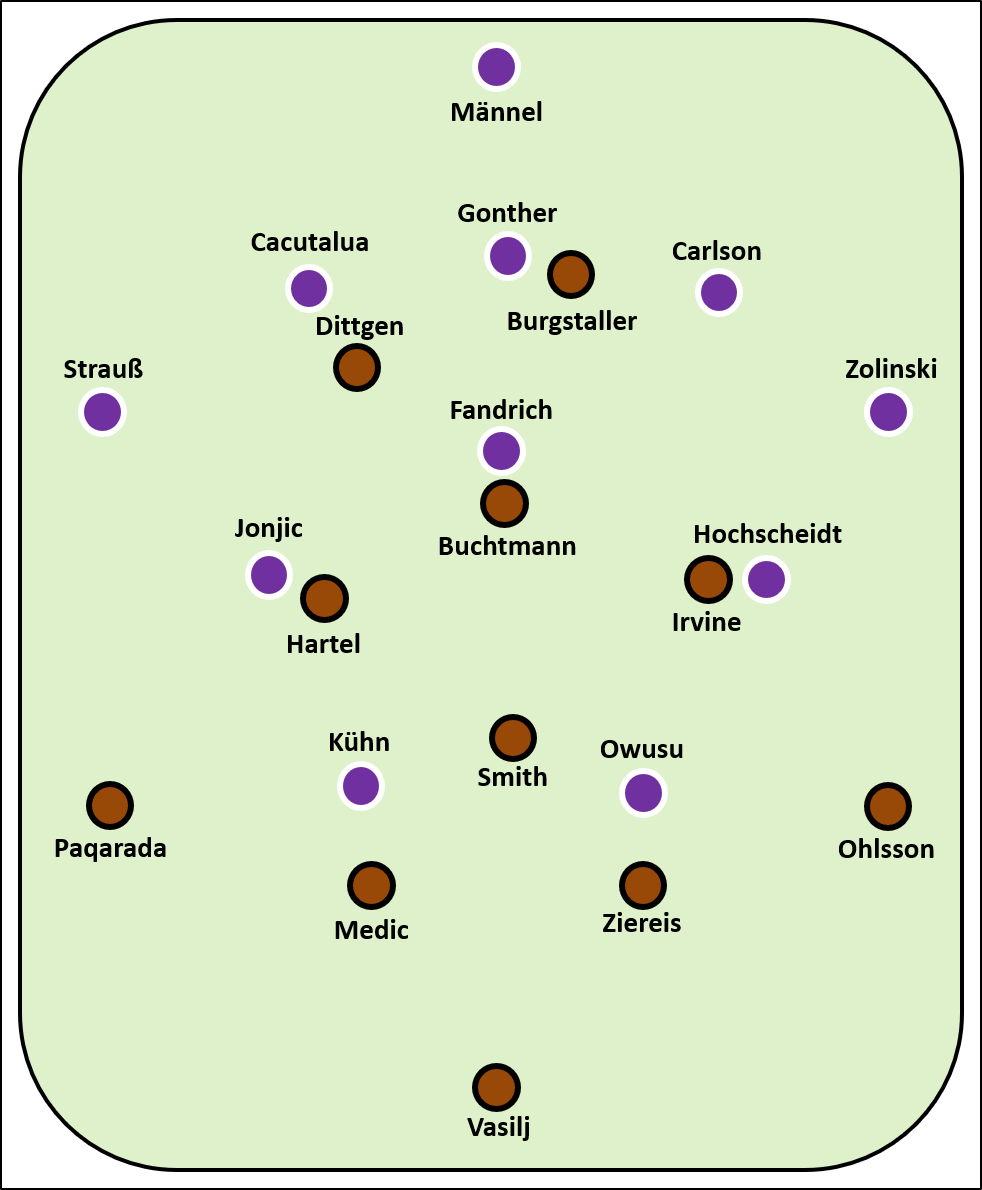
Hausaufgaben gemacht
Es war durchaus zu erwarten: Der FC Erzgebirge Aue hat sich die Spiele des FC St. Pauli gegen Holstein Kiel und Fortuna Düsseldorf angesehen und gedacht „Das machen wir auch!„. Entsprechend lief das Team in einem 3-5-2 auf und versuchte so das Aufbauspiel des FCSP, aber auch dessen offensive Positionierung gut aufzunehmen. Mit zwei Flügelverteidigern sollte es gelingen die Außenverteidiger des FC St. Pauli frühzeitig zu stören, ohne zuviel Raum in der letzten Kette zu geben. Das war nämlich genau der Raum, in den die FCSP-Angreifer dann reinstoßen wollten. Bei drei Innenverteidigern auf dem Platz und einer flexiblen Bewegung, je nachdem, wo sich der Ball befand, blieben die Räume für den FC St. Pauli eng und die Außenverteidiger konnten unter Druck gesetzt werden.
Wenn es richtig ausgespielt wird, dann handelt es sich beim 3-5-2 nicht um eine Dreier- bzw. Fünferkette, sondern vielmehr um eine Viererkette. Denn während der ballnahe Flügelverteidiger vorschiebt, lässt sich der ballferne Flügelverteidiger in die Kette fallen.
Genau das hat Erzgebirge Aue recht gut gemacht am Millerntor. Besonders die eigenen defensiven Außenbahnen, bei so einem System die anfälligste Zone, haben sie trotzdem weiter verhältnismäßig gut kontrolliert. Zumindest so gut, dass weder Dittgen noch Burgstaller auf diesen Seiten viel freien Raum hatten, wenn sie sich aus der Zentrale nach außen bewegten.
Drei Themen gab es nach Aussage von Timo Schultz, die der FC St. Pauli in der Winterpause und speziell im Wintertrainingslager bearbeitet hat. Das defensive Umschaltverhalten (kommen wir später zu), die eigenen Standards (auch das kommt dann gleich) und das Spiel gegen jenes 3-5-2. Letzteres hat eigentlich gar nicht so schlecht funktioniert und es waren definitiv einige Veränderungen erkennbar: Bei Ballbesitz des FC St. Pauli bewegten sich beide Stürmer auf die Außenbahn. Der in der Mitte nun unbesetzte Raum wurde von den vorschiebenden Rautenspielern besetzt (fast immer Irvine, seltener Hartel), allerdings war das Zentrum ganz vorne unbesetzt, solange das Team noch nicht im letzten Drittel war. Gerade die Vorwärtsbewegung der Halbpositionen war vor Jahreswechsel nicht so griffig und konsequent. Eine weitere Veränderung: Eric Smith bewegte sich im Spielaufbau konsequent zwischen die beiden Innenverteidiger. Dadurch konnten Sebastian Ohlsson und Leart Paqarada weiter hochschieben. Ohlsson tat das sehr weit außen. Paqarada hingegen rückte auch gerne mal in den Halbraum vor.
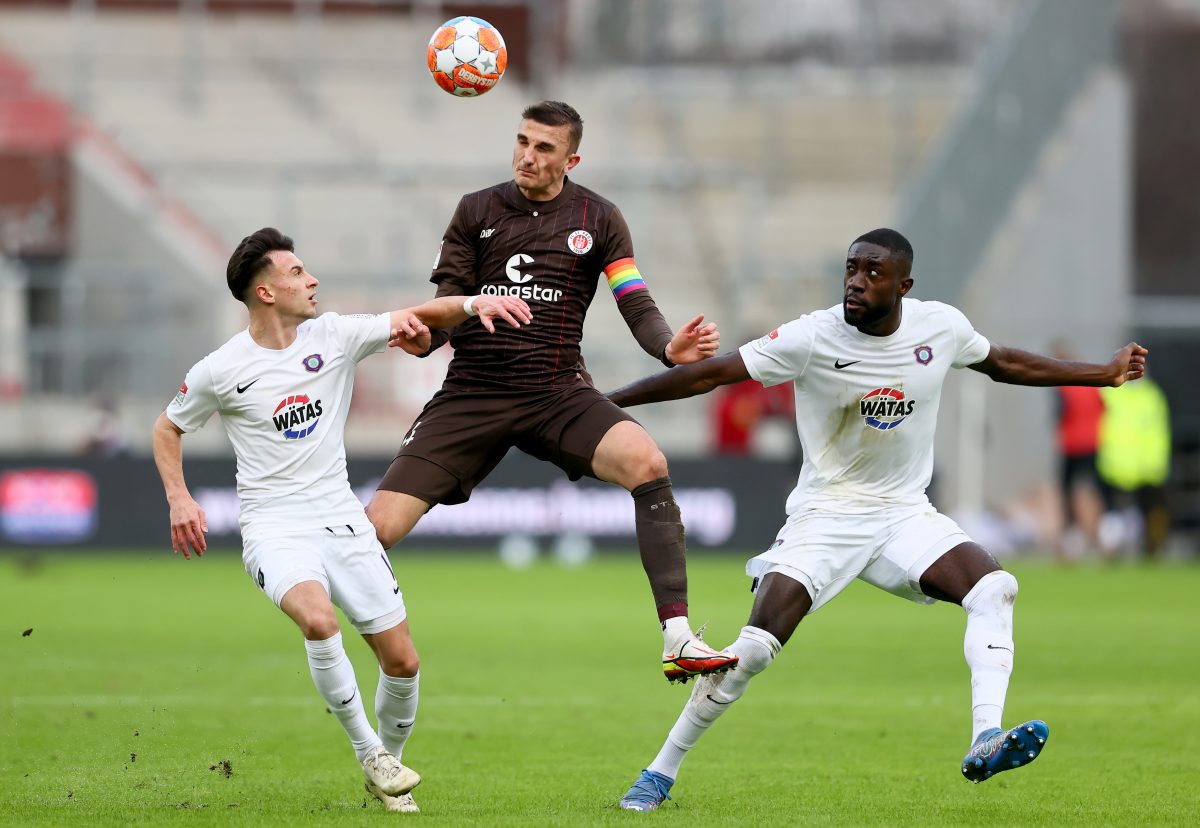
(Martin Rose/Getty Images/via OneFootball)
Die Bewegung von Smith führte auch dazu, dass Christopher Buchtmann von der Zehnerposition etwas weiter nach hinten fiel, um den zentralen Raum zu besetzen. Gerade diese Bewegung war, obwohl es ansonsten von der Spielanlage ganz gut aussah, für den FC St. Pauli ein Problem. Denn der Druck auf die letzte Reihe von Erzgebirge Aue blieb dadurch verhältnismäßig gering. Grundsätzlich ist kompakt stehen in einer defensiven Grundordnung gar nicht so schwer. Schwer wird es für Teams erst immer dann, wenn sie aus dieser Grundordnung vor Entscheidungen gestellt werden. Meist geschieht das dadurch, dass Spieler sich im Raum zwischen zwei Gegenspielern bewegen und dort dann die Frage auftaucht, wer für diesen Spieler verantwortlich ist. Dadurch werden die Spieler dann aus ihrer defensiven Grundordnung in Bewegung gebracht und das ist genau das, was gegnerische Teams erreichen wollen. Denn ein Team in defensiver Grundordnung kommt erst dann in Bewegung, wenn es auf etwas reagieren muss. Und da Reaktionen immer nach Aktionen geschehen, besitzt das agierende Team einen Vorteil. So hochgelobt die zweite Liga auch ist diese Saison: Es ist und bleibt die Königsdisziplin für ambitionierte Teams gegen solch destruktive Gegner, die primär in einer defensiven Grundordnung arbeiten, Lösungen zu finden. Im bisherigen Saisonverlauf ist das dem FC St. Pauli richtig gut gelungen. Gegen Erzgebirge Aue gab es aber Schwierigkeiten.
Denn dadurch, dass Buchtmann sich immer wieder zentral nach hinten bewegte, als Reaktion auf die Bewegung von Smith, war, vereinfacht dargestellt, die offensive Zentrale nicht ausreichend besetzt, um Erzgebirge Aue vor genug Entscheidungen zu stellen und sie in Bewegung zu bringen. Genau dieses kleine Problem im dominanten Spiel des FC St. Pauli führte dann zu einer Umstellung in der 2. Halbzeit.
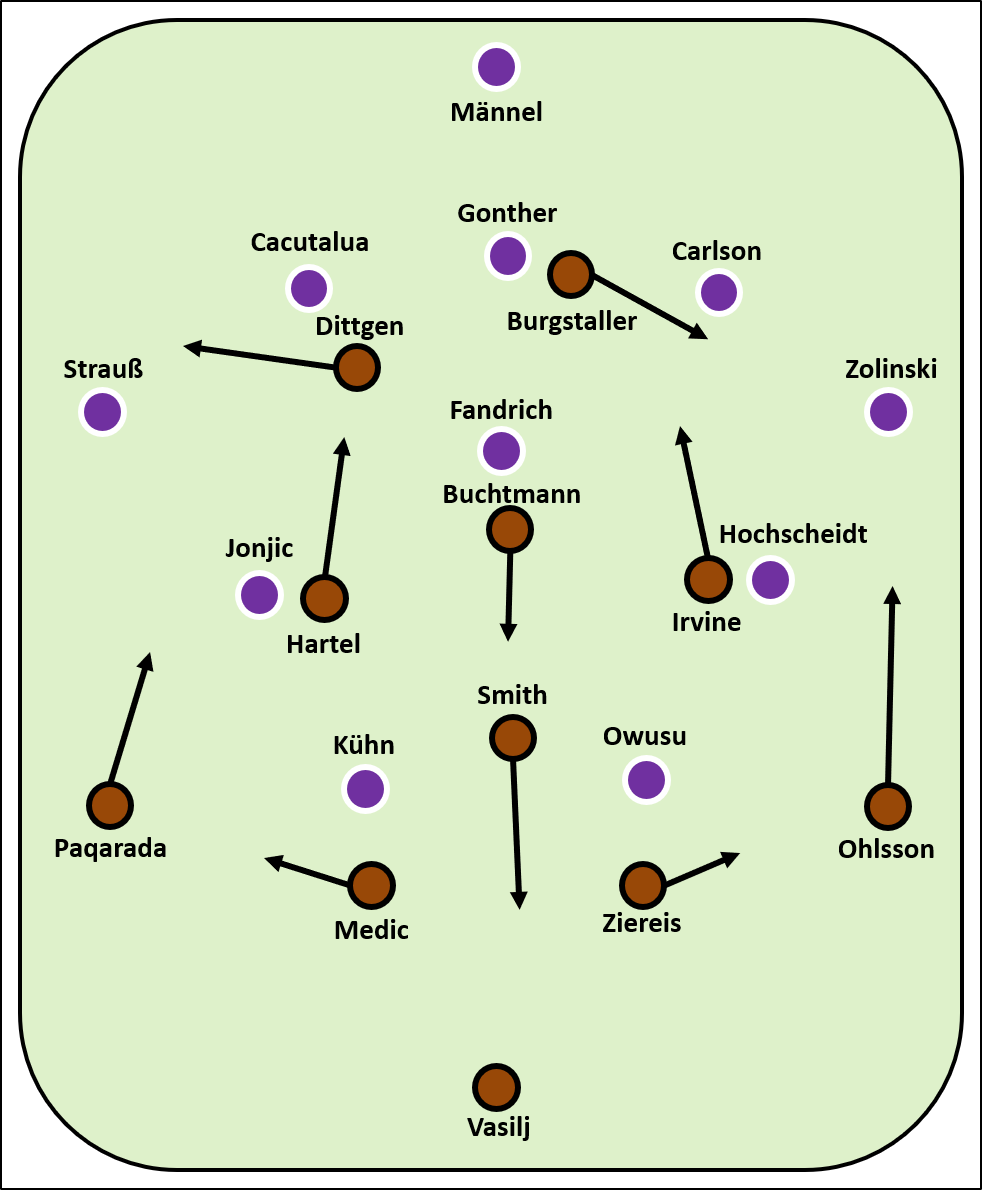
Bevor wir dieses nun lose Ende der Analyse weiter betrachten, schauen wir aber mal auf den Spielverlauf, denn der bildete das andere Kernproblem des FC St. Pauli. Es war wirklich bemerkenswert, wie Erzgebirge Aue mit dem Druck des FC St. Pauli bei eigenem Ballbesitz umging. Denn sie versuchten es immer und immer wieder flach zu lösen. Und das obwohl es eigentlich fast gar nicht klappte. Bis auf ein einziges Mal in der ersten Halbzeit war der Ball innerhalb von Sekunden wieder beim FC St. Pauli. Das Problem: Das eine Mal bei dem es klappte, führte zum Gegentor. Während der FCSP sehr dominant und mit viel Ballbesitz das Spiel diktierte, machte Aue aus der ersten Offensivaktion gleich das Tor. Mit einer Spieleröffnung, die dem Team ansonsten nichts als Ärger bescherte, stellten sie das Spiel auf den Kopf.
Das ist natürlich etwas, über das man sich vorzüglich ärgern kann. Aber es sei erwähnt, dass diese gnadenlose Effektivität sonst auch häufig auf Seiten des FC St. Pauli vorhanden war. Gerade in Spielen, in denen die Gegner tief warteten, wurde meist früh die Führung erzielt und damit dann auch gleich der Matchplan des Gegners über den Haufen geworfen. Gegen Erzgebirge Aue klappte genau das auch, allerdings für den Gegner.
Aue-Trainer Pavel Dotchev (ist ein Teil des Doppel-Gespanns mit Marc Hensel) sagte auf der Pressekonferenz nach dem Spiel, dass er gerade mit diesem flachen Aufbau in der ersten Halbzeit komplett unzufrieden gewesen ist (dabei schob Zolinski sehr hoch, sodass ein 4-5-1 entstand). Also genau mit dem Aufbau, der letztlich die Führung brachte. Laut Dotchev versuchte sein Team mit dem flachen Aufbau die erste Pressinglinie des FCSP zu locken und dann zu überspielen. Meist gelang dies jedoch nicht, viele Ballverluste noch in der eigenen Hälfte waren die Folge. So kam es dann zu einer Umstellung in der zweiten Halbzeit, die dem FC St. Pauli dann auch mehr Probleme bereitete.
Abgesehen davon, dass die Box ganz vorne nicht ausreichend besetzt war und dadurch Erzgebirge Aue nicht so richtig in Bewegung gebracht werden konnte, zeigte der FC St. Pauli aus meiner Sicht ein gutes Spiel in der ersten Halbzeit. Die Führung von Aue wurde rund eine Viertelstunde später ausgeglichen, da es endlich mal gelang eine Standard-Situation zu verwerten. Gerade in der ersten Halbzeit war auffällig, dass sich das Team damit im Winter beschäftigt hatte, da doch einige andere Einlaufwege genutzt wurden und Versuche Medić frei zu blocken. Und dann war es aber die Kombination, die bereits schon einmal in dieser Saison erfolgreich war: Freistoß-Flanke Smith auf den Kopf von Medić (DFB-Pokal in Magdeburg). Der Ausgleich war also geschafft und das Spiel lief gar nicht so schlecht. Ich möchte mich mal aus dem Fenster lehnen und behaupten, dass es nur eine Frage der Zeit gewesen wäre, bis der FCSP unter diesen Umständen in Führung gegangen wäre. Es kam in der zweiten Halbzeit aber alles anders…
Ungenauigkeit erhöht Ungeduld erhöht Ungenauigkeit erhöht Ungeduld erhöh…
Die zweite Halbzeit ist sicher eine, die für die Analyse des FCSP-Spiels in der weiteren Saison noch wichtig werden wird. Denn je länger sie dauerte, umso chaotischer, unruhiger und damit ungenauer wurde das eigene Spiel. Damit kommen wir zurück zum losen Ende rund um die Positionierung von Christopher Buchtmann. Denn zum Start der zweiten 45 Minuten stellte der FC St. Pauli seine Formation ein wenig um: Eric Smith blieb nun im Spielaufbau auf der Sechser-Position und fiel nicht mehr zwischen die Innenverteidiger. Stattdessen bildete Leart Paqarada mit den beiden Innenverteidigern nun die letzte Reihe im Ballbesitz. Ich habe Timo Schultz auf der PK nach dem Spiel gefragt, ob diese Umstellung so besprochen wurde:
„Ja, das war so geplant. Wir wollten mit drei Spielern aufbauen, haben dann Paqa mit in die Dreierkette genommen, damit wir im Zentrum noch einen Spieler mehr haben und Buchti noch ’ne Linie höher schieben kann.“
Timo Schultz zur veränderten Rolle von Eric Smith in der zweiten Halbzeit.
Durch diese Umstellung agierte der FC St. Pauli, auch wenn Timo Schultz von diesen Zahlenspielen nicht viel hält (schaut mal die PK nach dem Spiel) in einem 3-1-4-2. Denn Sebastian Ohlsson schob nun konsequent bei Ballbesitz weit hoch und Maximilian Dittgen wich nun ebenso konsequent auf die linke Seite aus.
Diese Umstellung war gut. Dem FCSP gelang es viel besser, Erzgebirge Aue vor Probleme zu stellen. Das Zentrum war nun mit Burgstaller und knapp dahinter Buchtmann sehr gut besetzt und somit wurden sehr viel mehr Entscheidungen von den drei Auer Innenverteidigern verlangt. Daher kam mehr Bewegung in die Hintermannschaft. Die erste Halbzeit war äußerst dominant vom FC St. Pauli, ohne jedoch wirklich zwingend zu werden. Ein Tor nach einem Standard, dazu ungewohnt wenige Chancen nach Einzelaktionen, das war es. Der Start in die zweite Halbzeit war dann aber sicher die beste Phase des FCSP und hätte, z.B. durch Jackson Irvine, durchaus mit einem Tor belohnt werden dürfen.
Aber je länger die Halbzeit lief, umso deutlicher wurde, dass auch Erzgebirge Aue sein Spiel umgestellt hatte und dies dem FC St. Pauli Probleme bereitete. Denn statt, wie noch in der ersten Halbzeit, flach hinten raus zu spielen, waren es nun stumpfe, aber gut abgestimmte lange Bälle, die Aue spielte. Insgesamt waren mehr als 30% der Pässe von Erzgebirge Aue lange Pässe – kein Team hat diese Saison gegen den FCSP eine höhere Quote gehabt. Timo Schultz nannte nach dem Spiel genau diese langen Bälle als größtes Problem. Denn die Innenverteidiger des FCSP hatten ein ums andere Mal Abstimmungsprobleme oder trafen nicht die richtigen Entscheidungen. Weniger als ein Drittel seiner Kopfballduelle konnte das Duo Medić/Ziereis gewinnen. Eine ungewohnt ausbaufähige Quote. In der zweiten Halbzeit wurde auch deutlich, warum Aue-Trainer Marc Hensel auf der PK vor dem Spiel die Verpflichtung von Prince Owusu so abfeierte. Denn Owusu ist sicher einer der Spieler gewesen, der die FCSP-Verteidigung allein aufgrund seiner Physis vor die größten Probleme stellte. Dazu war dann mit Nicolas Kühn ein sehr schneller „Wingman“ für Owusu vorhanden, der in der zweiten Halbzeit deutlich positionsgetreuer neben Owusu agierte.
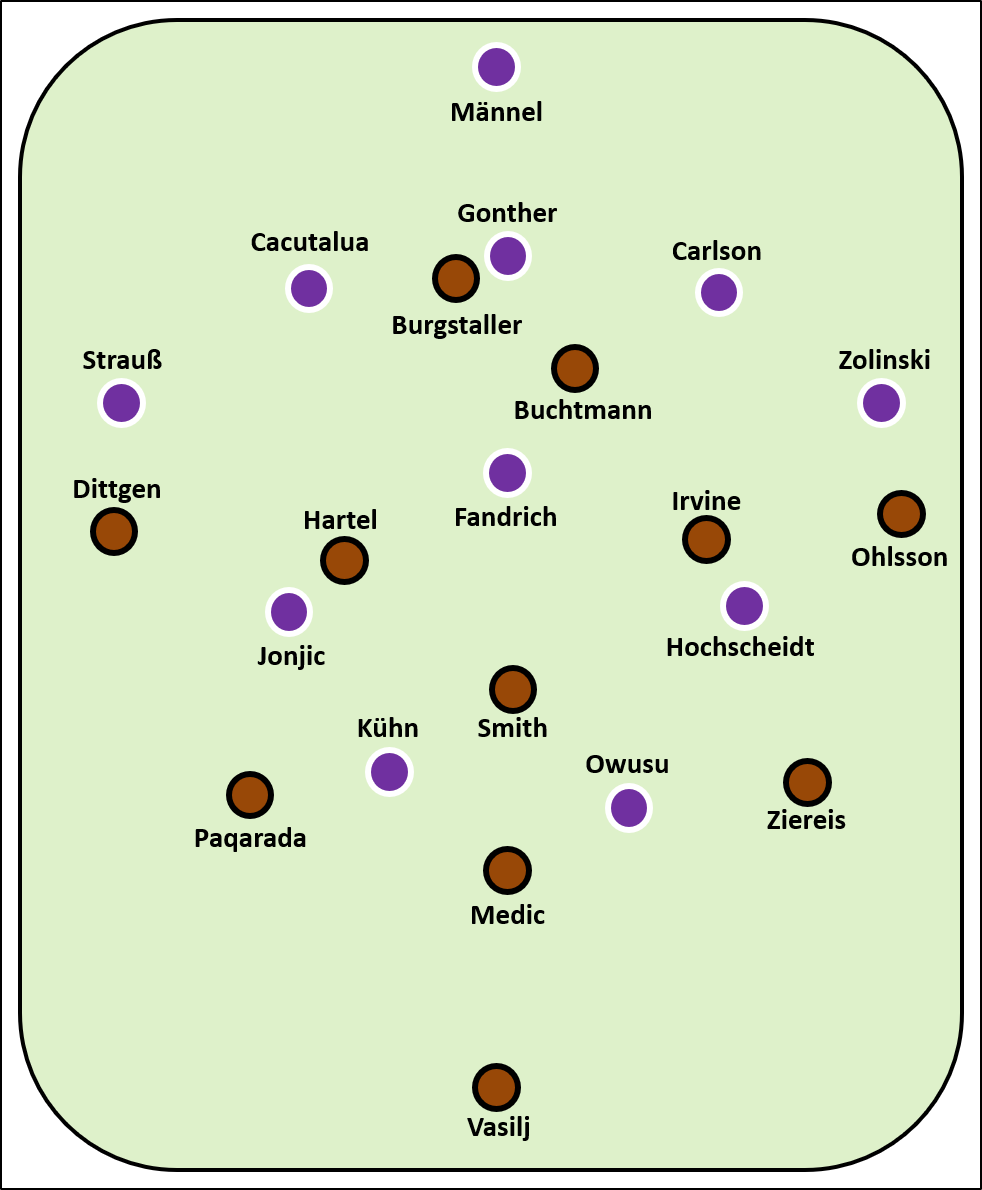
Problematisch wurde das alles für den FC St, Pauli vor allem deshalb, da das Team irgendwie ungeduldig wurde. Dabei hatte es eigentlich alles unter Kontrolle: Der frühe Rückstand wurde ausgeglichen und die zweite Halbzeit dominant begonnen. Mit über 70% Ballbesitz hatte der FCSP in diesem Spiel soviel Ballbesitz, wie noch nie in der Saison. Ungewohnt aber, dass das Team Mitte der zweiten Halbzeit bei einem Spiel zuhause nicht in Führung lag. Reicht das, um Ungeduld und Ungenauigkeit zu erzeugen? Eher nicht sofort. Aber mit jeder Minute mehr, wurde das Spiel des FCSP unrunder. Viele Ballverluste gab es aufgrund von ungenauen Pässen. Das sah dann zeitweise überhaupt nicht mehr nach der gut geölten Offensive der Hinrunde aus. Und das liest sich auch in der Statistik: Guido Burgstaller war vom Spiel nämlich nahezu abgeschnitten. Nur 12 empfangene Pässe – zusammen mit dem Hinspiel in Aue Tiefstwert. Zudem verlor er alle seine Offensivduelle und konnte, ebenfalls ungewohnt, gar keine gefährlichen Tor-Aktionen generieren.
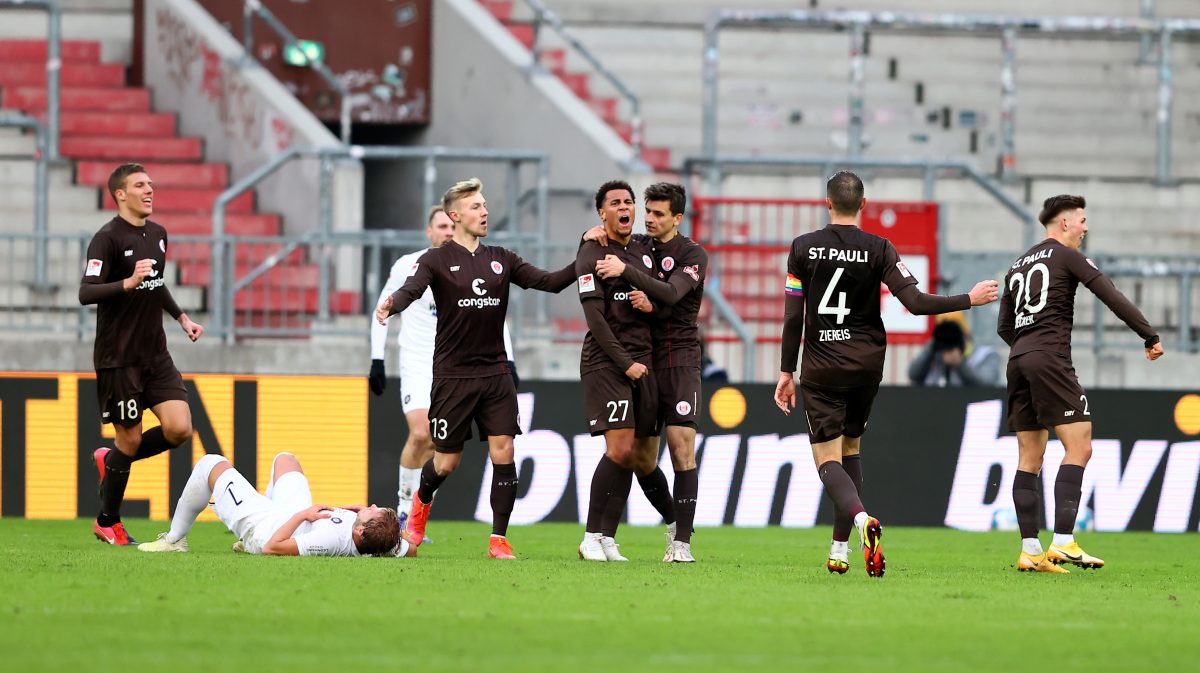
(Martin Rose/Getty Images/via OneFootball)
Es war dann wie ein Teufelskreis: Durch die ungenauen Aktionen wuchs die Ungeduld (und sicher auch der Frust) bei den Spielern, was wiederum die Ungenauigkeit erhöhte. Irgendwann war von dem gut geordneten Aufbauspiel nicht mehr viel übrig. Es verkam zu einem Spiel bestehend aus Einzelaktionen in der Offensive.
Die vielen Ballverluste zusammen mit den langen Bällen von Aue, wurden dann zunehmend ein Problem für die Defensive des FCSP. Besonders wackelig wirkte das Team in den defensiven Umschaltmomenten, also genau den Momenten, die im Winter besonders bearbeitet werden sollten. Und noch mehr dann, wenn die Bälle davor lang gespielt wurden. So geschehen vor dem 1:2, als Aue über einen langen Ball im zweiten Versuch in Ballbesitz kommt, gut verlagert und dann bereits einen ungeordneten Gegner vor sich hat. Der kurz zuvor eingewechselte Nikola Trujic veredelte den Latten-Abpraller (und wurde kurze Zeit später stark Gelb-Rot-gefährdet wieder ausgewechselt).
Für Ruhe sorgte das beim FC St. Pauli natürlich nicht. Vielmehr wurde so etwas wie eine Brechstange rausgeholt. Das ist aber natürlich nicht so das beste Element, wenn Du vorne keinen „Brecher“ drin hast. Keine Frage, Simon Makienok hätte dem Spiel des FCSP gut getan. Ich denke, er wäre es auch schon bevor die Brechstange das Mittel der Wahl war.
Die „Brechstange“-St.Pauli-Style ohne Makienok sah dann gelungene Einzelaktionen vor: Erst setzte sich Finn Ole Becker ganz fein gegen drei Gegenspieler durch und danach war es Etienne Amenyido, der zwei Gegenspieler aussteigen ließ und dann wirklich sehenswert ins Eck schlenzte – der Ausgleich in der 93. Minute! Aufgrund des Spielverlaufs sicher glücklich.
Kein Grund zur Unruhe – aber zum Sinne schärfen
Auf der Pressekonferenz nach dem Spiel war Timo Schultz leicht angefressen, ob der Fragen zu „verlorenen zwei Punkten“ und hob sinngemäß hervor, dass diese Erwartungshaltung sich stark verändert habe und ein Sieg gegen Aue als Pflichtaufgabe angesehen werde. Ja, wurde sie. Auch von mir. Kannst du auch niemandem erzählen, dass man vom spielerisch überlegenden Spitzenreiter im Heimspiel gegen den Tabellen-17. keinen Sieg erwarten darf.
Man muss aber auch den Spielverlauf betrachten und dass Erzgebirge Aue eben jenen mit der frühen Führung komplett auf den Kopf stellte. Eine schlechte Leistung des FC St. Pauli war das aber sicher nicht. Aber gerade das Verhalten in der zweiten Halbzeit, als ihnen die Spielkontrolle, selbstverschuldet, mehr und mehr entglitten ist, sollte genauer betrachtet werden. Natürlich kann nicht jedes Spiel wie geplant verlaufen. Natürlich kann nicht immer eine frühe Führung gelingen. Dem FC St. Pauli muss es in solchen Phasen gelingen die Ruhe zu bewahren und weiter auf die eigene Stärke zu vertrauen. Was man dem Team aber nicht absprechen kann, ist, dass sie, trotz des wirklich sehr unglücklichen Spielverlaufs, zu keinem Zeitpunkt aufgesteckt haben. Sie haben es immer weiter, bis zur letzten Sekunde, versucht. Finde ich gut und stimmt mich weiter optimistisch.
Immer weiter vor!
// Tim
Alle Beiträge beim MillernTon sind gratis. Wir freuen uns aber sehr, wenn Du uns unterstützt.
MillernTon auf BlueSky // Mastodon // Facebook // Instagram // Threads // WhatsApp // YouTube
{:}{:en}FC St. Pauli earns a point at home against Erzgebirge Aue. That was certainly not what many had expected before the game, but after the course of the game, it can be called lucky. After the game did not go according to plan in the first half, the team in brown and white lacked much of what had made them so strong recently towards the end of the second half.
(Cover picture: Martin Rose/Getty Images/via OneFootball)
The line-up
Compared to the last match before the winter break, there were some changes in the starting eleven of FC St. Pauli. Jakov Medić started in central defence in place of James Lawrence. Sebastian Ohlsson started at right-back, as Luca Zander is not yet fit again after his Corona infection (he was not in the squad). Daniel-Kofi Kyereh, who is at the Africa Cup, was replaced by Christopher Buchtmann, as had already been indicated in the test match in the training camp. Maximilian Dittgen also started again in attack alongside Guido Burgstaller. Igor Matanović remained on the bench for the time being. Simo Makienok, whom I had suspected in the preliminary report, was not in the squad, also due to a not so fit knee.
FC Erzgebirge Aue also made changes in a few positions: In central defence, Sören Gonther and Malcom Cacutalua came into play after a long break in each case. Clemens Fandrich returned to the six-man position after serving his suspension. Ben Zolinski and newcomer Prince Owusu started upfront.

Homework done
It was to be expected: FC Erzgebirge Aue watched the games of FC St. Pauli against Holstein Kiel and Fortuna Düsseldorf and thought „We’ll do that too! Accordingly, the team started in a 3-5-2 and tried to absorb FCSP’s build-up play as well as their offensive positioning. With two wing defenders, the aim was to disrupt the FC St. Pauli full-backs at an early stage without giving them too much space in the final chain. That was exactly the space into which the FC St. Pauli attackers wanted to push. With three centre-backs on the pitch and flexible movement depending on where the ball was, FC St. Pauli kept the spaces tight and was able to put the full-backs under pressure.
When played correctly, the 3-5-2 is not a three- or five-man chain, but rather a four-man chain. Because while the wing defender near the ball advances, the wing defender far from the ball drops into the chain.
That’s exactly what Erzgebirge Aue did quite well at the Millerntor. Especially their own defensive outer lanes, which are the most vulnerable zone in such a system, were still relatively well controlled. At least so well that neither Dittgen nor Burgstaller had much free space on these sides when they moved outwards from the centre.
According to Timo Schultz, there were three topics that FC St. Pauli worked on during the winter break and especially in the winter training camp. The defensive transitioning behaviour (we’ll get to that later), the own set-pieces (that will also come in a moment) and the game against that 3-5-2. The latter actually didn’t work that badly and there were some changes recognisable: When FC St. Pauli had possession of the ball, both strikers moved to the outer lane. The space now unoccupied in the middle was occupied by the forward diamond players (almost always Irvine, rarely Hartel), but the centre-right in front was unoccupied as long as the team was not yet in the final third. The forward movement of the half positions in particular was not as gripping and consistent before the turn of the year. Another change: Eric Smith moved consistently between the two centre-backs in the build-up to the game. This allowed Sebastian Ohlsson and Leart Paqarada to push further up. Ohlsson did this very far out. Paqarada, on the other hand, was happy to move forward into the half-area.

(Martin Rose/Getty Images/via OneFootball)
Smith’s movement also led to Christopher Buchtmann dropping a little further back from the ten-man position to occupy the central space. It was precisely this movement that was a problem for FC St. Pauli, although otherwise, the game looked quite good. The pressure on Erzgebirge Aue’s backline remained relatively low. In principle, standing compactly in a defensive basic order is not that difficult. It only becomes difficult for teams when they are confronted with decisions from this basic order. This usually happens when players move in the space between two opponents and the question arises as to who is responsible for this player. This then gets the players moving out of their basic defensive order and that is exactly what opposing teams want to achieve. Because a team in a defensive basic order only gets moving when it has to react to something. And since reactions always happen after actions, the team in action has an advantage. As highly praised as the second division is this season, it is and remains the supreme discipline for ambitious teams to find solutions against such destructive opponents, who primarily work in a defensive basic order. In the course of the season so far, FC St. Pauli has succeeded well. Against Erzgebirge Aue, however, there were difficulties.
Because the fact that Buchtmann kept moving centrally to the back in reaction to Smith’s movement meant, in simple terms, that the offensive centre was not sufficiently manned to present Erzgebirge Aue with enough decisions and get them moving. It was precisely this small problem in FC St. Pauli’s dominant play that then led to a change in the 2nd half.

Before we look at this loose end of the analysis, let’s have a look at the course of the game, because this was the other core problem of FC St. Pauli. It was remarkable how Erzgebirge Aue dealt with the pressure of FC St. Pauli in their possession. Because they tried to solve it again and again flat. And that although it almost didn’t work at all. Except for one time in the first half, the ball was back in FC St. Pauli’s possession within seconds. The problem: The one time it worked, it led to a goal against. While FC St. Pauli dominated the game with a lot of possession, Aue scored from their first offensive action. With an opening that otherwise caused the team nothing but trouble, they turned the game on its head.
Of course, that is something to be exquisitely angry about. But it should be mentioned that this merciless effectiveness was otherwise also often present on the side of FC St. Pauli. Especially in games in which the opponents were waiting deep, they usually took the lead early on and then immediately threw the opponent’s match plan overboard. Against Erzgebirge Aue, exactly that worked out, but for the opponent.
Aue coach Pavel Dotchev (part of the double team with Marc Hensel) said at the post-match press conference that he was completely dissatisfied with the flat build-up in the first half (Zolinski pushed very high, creating a 4-5-1). In other words, exactly with the set-up that ultimately brought the lead. According to Dotchev, his team tried to lure FCSP’s first pressing line with the flat build-up and then play over it. Most of the time, however, this was not successful, and many ball losses in the own half were the result. This led to a change in the second half, which caused more problems for FC St. Pauli.
Apart from the fact that the box at the front was not sufficiently occupied and Erzgebirge Aue could not really get going, FC St. Pauli showed a good game in the first half from my point of view. Aue’s lead was equalised about a quarter of an hour later, as they finally managed to convert a set-piece. Especially in the first half, it was noticeable that the team had been preoccupied with this in the winter, as several other entry routes were used and attempts were made to block Medić free. But then it was the combination that had already been successful once this season: Smith’s free-kick crossed onto Medić’s head (DFB-Pokal in Magdeburg). So the equaliser was there and the game wasn’t going badly at all. I would go out on a limb and say that it would only have been a matter of time before FCSP had taken the lead under these circumstances. But everything turned out differently in the second half…
Inaccuracy increases Impatience increases Inaccuracy increases Impatience increases…
The second half is certainly one that will be important for the analysis of the FCSP game in the rest of the season. Because the longer it lasted, the more chaotic, restless and thus inaccurate our own game became. This brings us back to the loose end around the positioning of Christopher Buchtmann. For at the start of the second 45 minutes, FC St. Pauli changed their formation a little: Eric Smith now stayed in the six-position in the build-up to the game and no longer dropped between the centre-backs. Instead, Leart Paqarada now formed the back row in possession with the two centre-backs. I asked Timo Schultz at the PK after the game whether this change had been discussed:
„Yes, that was the plan. We wanted to build up with three players, then we took Paqa into the three-man backline so that we have one more player in the centre and Buchti can push one line higher.“
Timo Schultz on Eric Smith’s changed role in the second half.
This change meant that FC St. Pauli, even if Timo Schultz doesn’t think much of these number games (have a look at the PK after the game), operated in a 3-1-4-2 because Sebastian Ohlsson now consistently pushed wide when in possession and Maximilian Dittgen now just as consistently moved out to the left.
This change was good. FCSP managed much better to cause problems for Erzgebirge Aue. The centre was now very well manned with Burgstaller and just behind him Buchtmann and thus many more decisions were required from the three Aue centre-backs. Therefore, there was more movement in the backline. The first half was extremely dominant for FC St. Pauli, but without being truly compelling. One goal after a set-piece, plus unusually few chances after individual actions, that was it. The start of the second half was certainly FCSP’s best phase and could have been rewarded with a goal, e.g. by Jackson Irvine.
But the longer the half went on, the clearer it became that Erzgebirge Aue had also changed their game and this was causing problems for FC St. Pauli. Instead of playing flat out at the back, as in the first half, it was now blunt but well-timed long balls that Aue played. Overall, more than 30% of Erzgebirge Aue’s passes were long passes – no team has had a higher rate against FCSP this season. Timo Schultz named exactly these long balls as the biggest problem after the game. Because the FCSP centre-backs had coordination problems time and again or did not make the right decisions. The Medić/Ziereis duo won less than a third of their headers. This was an unusually poor performance. In the second half, it also became clear why Aue coach Marc Hensel celebrated the signing of Prince Owusu so much at the pre-match press conference. Owusu was certainly one of the players who posed the biggest problems for the FCSP defence due to his physicality alone. In addition, Nicolas Kühn was a very fast „wingman“ for Owusu, who acted in a much more positional manner next to Owusu in the second half.

It all became problematic for FC St. Pauli mainly because the team somehow became impatient. Actually, everything was under control: The early deficit was compensated and the second half started dominantly. With more than 70% possession, FCSP had more possession in this game than ever before in the season. Unusually, however, the team was not in the lead midway through the second half in a game at home. Is that enough to create impatience and inaccuracy? Rather not immediately. But with every minute that passed, FCSP’s game became less rounded. There were many ball losses due to inaccurate passes. At times, it no longer looked like the well-oiled offensive of the first half. And this is also reflected in the statistics: Guido Burgstaller was almost cut off from the game. Only 12 passes were received – together with the first leg in Aue the lowest value. In addition, he lost all his offensive duels and, also unusually, was unable to generate any dangerous goal-scoring actions.
It was then like a vicious circle: The imprecise actions increased the impatience (and certainly the frustration) of the players, which in turn increased the imprecision. At some point, there was not much left of the well-ordered build-up play. It degenerated into a game of individual offensive actions.
The many ball losses together with the long balls from Aue became more and more a problem for the FCSP defence. The team looked particularly shaky in the defensive switching moments, exactly the moments that should be worked on in the winter. And even more so when the balls were played long beforehand. That’s what happened before the 1:2, when Aue gained possession via a long ball at the second attempt, shifted well and then already had a disorganised opponent in front of them. Nikola Trujic, who had been substituted shortly before, finished the rebound off the crossbar (and was substituted again a short time later with a severe yellow card).
Of course, this did not bring peace to FC St. Pauli. Rather, something like a crowbar was brought out. But of course, that’s not the best element if you don’t have a „breaker“ upfront. There’s no question that Simon Makienok would have done FCSP’s game good. I think he would have been even before the crowbar was the tool of choice.
The „crowbar“-St. Pauli-style without Makienok then saw successful individual actions: First, Finn Ole Becker was able to beat three opponents and then it was Etienne Amenyido who let two opponents by and then flicked a really impressive shot into the corner – the equaliser in the 93rd minute! Given the course of the game, it was certainly a happy one.
No reason to worry – but to sharpen your senses
At the post-match press conference, Timo Schultz was slightly miffed at the questions about the „lost two points“ and emphasised that the expectations had changed considerably and that a win against Aue was considered a must. Yes, it was. Also by me. You can’t tell anyone that you can’t expect a victory at home against the 17th-placed team in the table from the leader who is superior in terms of play.
But you also have to look at the course of the game and the fact that Erzgebirge Aue completely turned it on its head with the early lead. This was certainly not a bad performance by FC St. Pauli. But especially the behaviour in the second half, when they lost more and more control of the game through their own fault, should be looked at more closely. Of course, not every game can go as planned. Of course, an early lead cannot always be achieved. FC St. Pauli must manage to stay calm in such phases and continue to trust in their own strength. But what you can’t deny the team is that, despite the very unfortunate course of the game, they never gave up. They kept trying until the last second. I think that’s good and makes me optimistic.
Keep moving forward!
//Tim (translation by Arne)
MillernTon Twitter //
MillernTon YouTube //
MillernTon Facebook //MillernTon Instagram //
If you like what we do here, here you’ll find the information on how to support us.
{:}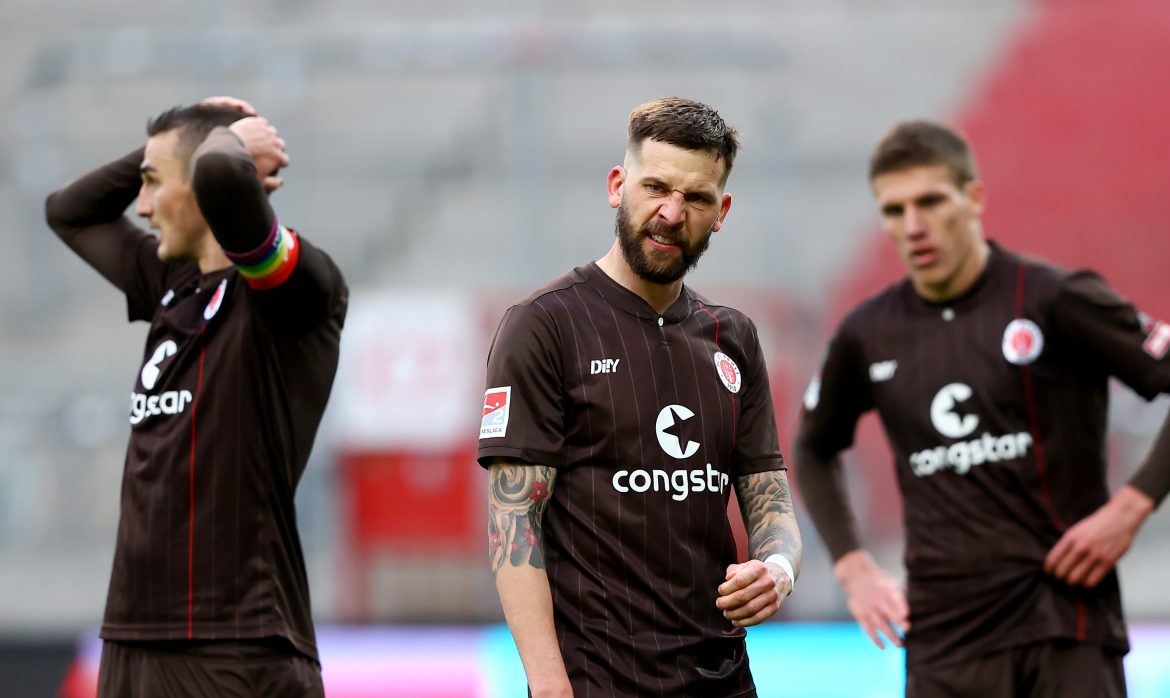

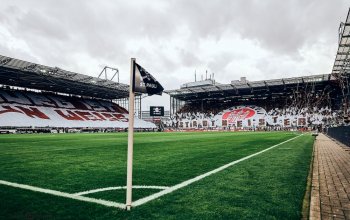

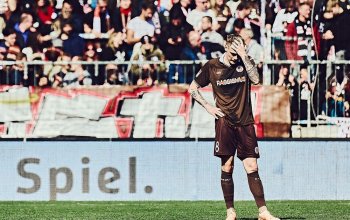
Burgstaller hatte die Kopfballchance von Irvine vorbereitet, eine gelungene Aktion war also dabei. Davon abgesehen war zumindest am Bildschirm nicht viel zu sehen.
Unserem Spiel hätte Becker meines Erachtens eher gut getan als Makienok. Den Grund dafür hat man beim Ausgleich gesehen. Mit Makienok hätten wir noch mehr lange Bälle Richtung Strafraum gebolzt, die einfacher für einen tief stehenden Gegner zu verteidigen sind. Wir sollten nach den eigenen Stärken spielen und die sehe ich eher im Fußball spielen und einem starken zentralen Mittelfeld.
Ich stimmt Dir zu und würde Dir widersprechen! Warum nicht Makienok UND Becker. Makienok um eben eine weitere Option im Offensivspiel zu haben (Brechstange) und dann Becker, ich hätt ihn gerne schon früher in der 2. Halbzeit gesehen, um mehr spielerische Klasse zu haben, die ohne Kyereh vorne – zumindest in diesem Spiel – fehlte. Wie Tim schon schrieb und Ewald im FCSP TV Talk nach dem Spiel erwähnte, es war nicht das erste Mal und wird nicht das letzte sein, dass die Gegner gegen uns so spielen werden, das heißt dann eben auch, dass unsere Stärke schwer umzusetzen wird und Alternativen mittels einer Brechstange über Makienok oder mittels eines Seitenwechsels über hochpositionierte Außen genutzt werden müssen, um solch Bollwerke zu knacken.
Denn, wenn dann die Chancen früh im Spiel genutzt werden – wie es auch hier gegen Aue der Fall hätte sein können -, ist der Spielplan des Gegners zunichte gemacht und die von Dir angesprochene Stärke von uns, kann wieder mehr zum Vorschein kommen, wenn die Gegner selber mehr Räume im Zentrum anbieten!
Ja, Becker hat da nochmal ziemlich viel Wind reingebracht und für Aue war es auch ein klares Mismatch so einen technisch versierten Spieler gegen sich auf der Halbposition zu haben.
Bisher konnte man sich darauf verlassen, dass die Ersatzspieler ohne großen Qualitätsverlust einspringen konnten. Gestern ist aber schon aufgefallen dass Ohlsson und Buchtmann ziemlich schwach waren, insbesondere offensiv aber auch defensiv (Ohlsson lässt sich beim 1-0 ohne Not Überholen).
Hoffentlich können die ihre Leistung in den kommenden beiden Spielen steigern.
Abgesehen vom 0-1 habe ich Ohlsson eigentlich gar nicht so schwach wahrgenommen. Ich finde der ist von seiner Spielweise her einfach immer grundsolide und hat selten Ausreißer nach oben und unten. Das macht ihn so stark.
Bei Buchtmann gebe ich dir recht. Er schien mit der Rolle etwas überfordert und hat da auch einfach einen Tempo-Nachteil im Vergleich zu Kyereh.
defensiv ist grundsolide ja was gutes, aber offensiv ist das zu wenig. Da braucht es auch schon mal eine besondere Aktion – Ausreißer nach oben – für die man Ausreißer nach unten in Kauf nimmt.
Da die Außenverteidiger mit der quasi 3er-Kette im Aufbau recht hoch und offensiv standen, kam Ohlsson eine offensivere Rolle zu als sonst, die er mM nach leider nicht ausfüllen konnte.
Die IV hatte sicherlich nicht ihren besten Tag. Allerdings – und das unterstreicht die Analyse nur – wurden sie vom MF auch arg alleine gelassen in HZ 2: Unglaublich, wie Aue mit einfachen „langem Hafer“ immer wieder 2:2 oder 3:3 Situationen schaffen konnte. Bei dem hohem Tempo solcher Aktionen wahrlich kein Vergnügen für die Verteidiger.
Neben Ohlsson fand ich vor allem Dittgen schwach: Einmal frage ich mich, warum Schultz gegen Mannschaften, die uns keine Räume anbieten, Dittgen aufstellt. Anfangs der zweiten Halbzeit hatte er zwei, drei vernünftige Szenen, in denen er von seiner Körperlichkeit profitieren konnte (und Aue noch nicht auf das „neue“ Aufbauspiel eingestellt war), das war es aber auch. Ohne die Möglichkeit tiefer Läufe erweisen sich seine Technik sowohl im 1:1 als auch im Paßspiel als zu schwach, um den Gegner vor Probleme zu stellen. Amenyido hätte mir als zweite Spitze deutlich mehr eingeleuchtet. Überhaupt ein Problem der Mannschaft gegen solche Gegner, dass zu wenige Spieler direkte Duelle suchen oder gar gewinnen können (Kyereh mal ausgenommen)…
Ja, ich hätte auch als letztes auf Dittgen neben Burgstaller getippt, da es eben genau diese Räume nicht gibt in einem Spiel gegen Aue. Die deutliche Positionierung auf der linken Seite zeigte aber auch, dass da schon ein gewisser Plan hinter steckte. Funktioniert hat er eher nicht. Aber ich habe auch Zweifel, ob das mit anderen Stürmern besser geklappt hätte. Immerhin war Burgstaller auch komplett abgeschnitten vom Spiel.
Ich finde Dittgens Passspiel überraschend stark (herausragende Beispiele waren seine Beteiligungen an den späten Siegtreffern von Zalazar und Matanovic letzte Saison). Er hat ein gutes Auge für den richtigen Raum und auch die Passqualität diesen anzuspielen. Dafür muss er aber eher hinter den Stürmern spielen.
Davon abgesehen stimme ich aber zu, dass er als Stürmer gegen einen tief stehenden Gegner nicht die beste Wahl ist, insbesondere, wenn nicht Kyereh auf der 10 spielt. Der Weg für Irvine von der 8 in den Strafraum ist mir in vielen Situationen auch zu weit, um das aufzufangen.
Dem habe ich nichts hinzuzufügen
Für mich als jemand, der das Spiel gesehen hat, ist der Kurzbericht eher überflüssig. Die taktische Analyse zieh ich mir gern irgendwann später genussvoll rein. Und ich lern da Sachen, von denen ich Jahrzehnte nichts wusste und trotzdem weiter ins Stadion gegangen bin.
Danke für die Rückmeldung. Ja, der Kurzbericht ist eher etwas für diejenigen, die vielleicht nicht alles gesehen haben oder nicht im Stadion waren.
Schön für Dich, Sorgi, wenn Du im Stadion warst. Aber am Bildschirm konnte ich immer nur Ausschnitte sehen und nichts richtig begreifen. Und in den Stunden nach Abpfiff (und ohne Freunde um mich herum) war mir sehr nach kritisch, konstruktiver Analyse. Da fühlt man sich dank eines spontanen Kommentars nicht so alleingelassen.
Schön, dass Du dich nicht alleingelassen fühlst <3